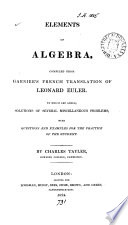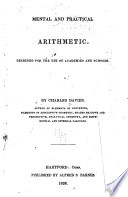 | James Maginness - 1821 - 378 σελίδες
...second terms together, and dividing by the third. 6. By statements 3d and 4th, the answers are found by multiplying the second and third terms together, and dividing by the first; which is in fact multiplying the same terms together, and dividing by the same divisors as before.-... | |
 | Charles Tayler - 1824 - 350 σελίδες
...they have been shown to possess. For instance, in the Rule of Three, if the terms be large, instead of multiplying the second and third terms together, and dividing by the first, we have only to add together the logarithms of the 2d and 3d terms, and to subtract from their sum the... | |
 | 1828 - 664 σελίδες
...30,7 inches or observed height, so is 100 or the observed volume to a fourth proportional obtained by multiplying the second and third terms together and dividing by the first : thus 30,7 X 100 = 3070, which divided by 30 = 102,333 cubic inches ; this would be the volume of... | |
 | Michael Faraday - 1831 - 706 σελίδες
...inches, or observed height, so is 100, or the observed volume, to a fourth proportional obtained by multiplying the second and third terms together and dividing by the first: thus, 30.7x100=3070, which divided by 30=102.333 cubic inches ; this would be the volume of the gas... | |
 | Charles Davies - 1833 - 284 σελίδες
...$6, its interest for one year, as $650 to its interest for the same time. The fourth term is found by multiplying the second and third terms together and dividing by the first, § 109. Hence the reason of the rule is evident. 2. What is the interest on $950 for four years at... | |
 | George Willson - 1836 - 202 σελίδες
...12 is less than 20. Moreover, the product of the means is not — as in all true proportions^equal to the product of the extremes. As the distinction...is stated thus : ddm 8 : 20 : : 12 : A. Multiplying trie second and third terms together, and dividing by the first we shall have the answer; 30 men. There... | |
 | Charles Davies - 1838 - 292 σελίδες
...$6, its interest for one year, as $650 to its interest for the same time. The fourth term is found by multiplying the second and, third terms together and dividing by the first § 14O. 2. What is the interest on $950 for four years at 7 per cent per annum ? OPERATION. We first... | |
 | Nathan Daboll - 1839 - 220 σελίδες
...fractions depend on the same principle as whole numbers, and this produces the jjame effect as that of multiplying the second and third terms together and dividing by the first ; therefore, the first term being a divisor, we invert it as taught (fl Division of Vulgar Fraction*... | |
 | William Ruger - 1841 - 268 σελίδες
...: i : : ™ £ff*-£l 3s. 4d., the Answer. PEM. — Inverting the first term is exactly the same as multiplying the second and third terms together and dividing by the first, as plainly appears from Division of Vulgar Fractions, therefore the same reasoning might be offered... | |
 | William Chauvenet - 1843 - 102 σελίδες
...too great. 80. To find the fourth term of a proportion. The fourth term of a proportion is found by multiplying the second and third terms together, and dividing by the first. In logarithms this is effected by adding the logarithms of the second and third terms and subtracting... | |
| |